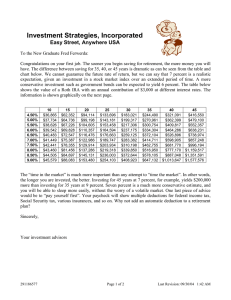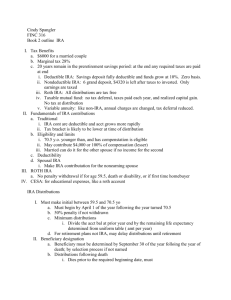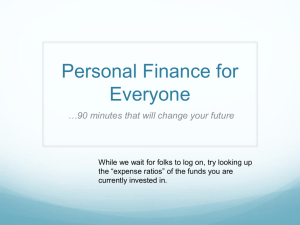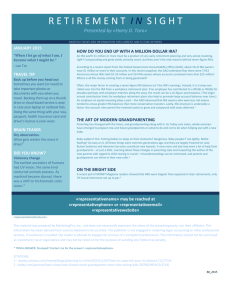5 Effective Savings Strategies Copy
advertisement
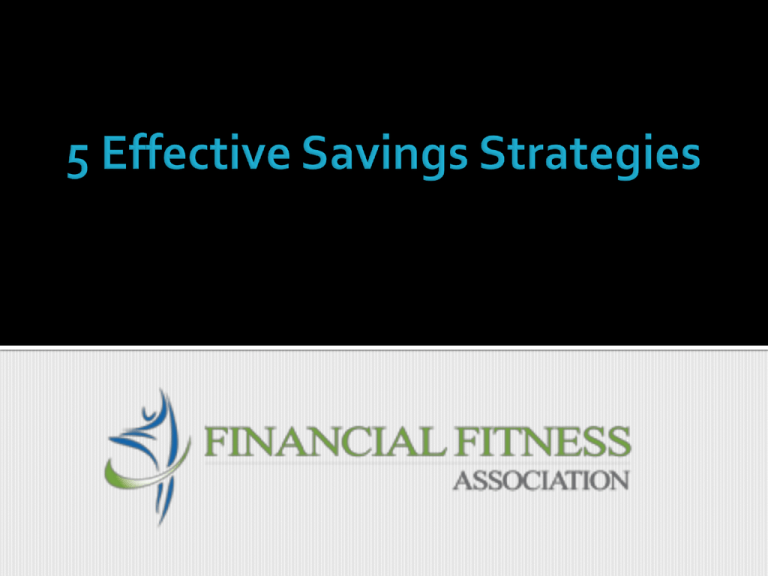
The Basics Saving vs. Investing The Time Value of Money The Miracle of Compounding Interest The How 1. Make Automatic Transfers 2. Set Up Investment Ladders 3. Open Tax-advantaged Accounts 4. Consolidate High-Interest Debt 5. Pay Extra Toward Principal SAVING Usually to meet short-term goals. Earn modest amount of interest. Savings and/or Money Market Account. Money is “liquid” and easily accessible. INVESTING Setting money aside for longer-term goals. Investments rise and fall in value over time. Certificates (CDs) and real estate (homes). Make more than Savings Account in the long run. Money is not as easily accessible. Relationship between money, rate of interest, and time. The more money you have to save or invest, the more money you are likely to earn. 2. The higher the rate of interest you earn, the more money you are likely to have. 3. The sooner you invest your money, the more time it has to make new money = $$$. 1. The reason this “time value of money” concept works is because of the miracle of compounding interest. Albert Einstein called compounding “the most powerful force in the universe”. Compound interest arises when interest is added to the principal of a deposit or loan, so that, from that moment on, the interest that has been added also earns interest. It’s easy to say you don’t have enough money to start saving and investing now, but that decision probably costs you more that you think because the power of compounding works both ways. NOW IS THE TIME to start saving and investing! “Out of Sight, Out of Mind” -what you don't see, you will probably not miss. Payroll Deduction into a Savings Account or US Savings Bond. Automatic Transfers from Checking to Savings Account. Pay yourself first before you pay your bills! Consider a Money Market Account for higher balances. Highly liquid account within limits of Regulation D. Find a money market account that has several different tiers that allow you to get better a rate the more you save. The higher the balance, the higher the yield. May be distributed for IRA strategy Use an investment ladder to maximize yields while hedging against interest rate movements. Example: Member has $20K in available cash. A three-year investment ladder could be used as follows: $5K in a 3-year Certificate $5K in a 2-year Certificate $5K in a 1-year Certificate $5K in a Money Market Account Benefits: Mitigates exposure to interest rate changes. Locks in both short-term and long-term rates. Provides steady dividend income. Minimizes re-investment risk. Only a portion of your investment matures at any given time. ▪ If interest rates fall, only the maturing portion is reinvested at the lower interest rate levels. ▪ If interest rates rise, you benefit by reinvesting the maturing CDs at higher rates. 401(k) –Pre tax contributions that grows tax deferred. Roth 401(k) –Post tax contributions, but tax free under normal distributions. Benefits of 401(k) accounts are: Employer-sponsored retirement plans; deducted directly from wages. Employer may match percentage of contributions (i.e. 3%) – FREE money. Generally no income limitations. Choose investments for growth: mutual funds, stocks, bonds, etc. Contribution limits: $15.5k/yr for < age 50, $20.5k/yr for > age 50.* Distributions begin at 59½ or if owner becomes disabled. Traditional IRA –Contributions may be tax deductible, earnings grow tax deferred. Roth IRA –Contributions are never tax deductible, but you get tax free withdrawal. Individual Retirement Accounts (IRAs) accounts are: Usually set up after 401(k) limits have been reached. Contributions are made with net income. Your income may limit contributions to a Roth IRA. No forced distribution for a Roth IRA. Contribution limits $5k/yr for < age 49, $6k/yr for > age 50.* Distributions begin at 59½ or if owner becomes disabled. Educational IRA Up to $500 per year; money grows tax-free and has preferential tax treatment at distribution for beneficiary.* Must be used for education purposes, very restrictive on who can make contributions and what exact education expenses qualify. Simplified Employee Pension (SEP) IRA Employer established and funded; employer puts up to 15% of your compensation into a special IRA account. If you have debts with interest rates in the double digits, consider a debt consolidation loan. Take out a single, lower-interest loan Low APR Credit Card Balance Transfer Home Equity Loan or Lines of Credit Cash-out Refinancing Personal Loan Making one monthly payment at a lower rate may help you pay off your debt faster. And don’t accrue new debt once you take out this loan! Paying a little extra toward the principal will help you build equity and pay off the loan faster –plus, you’ll save money on interest. For a mortgage, the initial payments will primarily go toward interest and the final payments primarily toward principal. Make sure your mortgage does not have a prepayment penalty. Consider writing a separate check, clearly marked “Payment toward principal”. For more info, please visit financialfitnessassociation.org.
